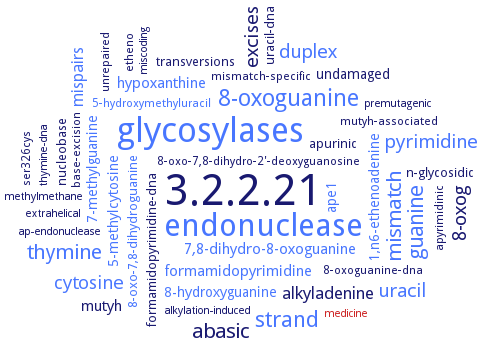3.2.2.21: DNA-3-methyladenine glycosylase II
This is an abbreviated version!
For detailed information about DNA-3-methyladenine glycosylase II, go to the full flat file.

Word Map on EC 3.2.2.21 
-
3.2.2.21
-
glycosylases
-
endonuclease
-
8-oxoguanine
-
strand
-
guanine
-
thymine
-
mismatch
-
abasic
-
pyrimidine
-
uracil
-
duplex
-
8-oxog
-
excises
-
cytosine
-
alkyladenine
-
mispairs
-
mutyh
-
7,8-dihydro-8-oxoguanine
-
formamidopyrimidine
-
hypoxanthine
-
7-methylguanine
-
ape1
-
5-methylcytosine
-
1,n6-ethenoadenine
-
undamaged
-
8-hydroxyguanine
-
8-oxo-7,8-dihydroguanine
-
formamidopyrimidine-dna
-
nucleobase
-
transversions
-
apurinic
-
uracil-dna
-
n-glycosidic
-
ser326cys
-
etheno
-
mutyh-associated
-
unrepaired
-
mismatch-specific
-
8-oxo-7,8-dihydro-2'-deoxyguanosine
-
base-excision
-
5-hydroxymethyluracil
-
apyrimidinic
-
8-oxoguanine-dna
-
premutagenic
-
alkylation-induced
-
ap-endonuclease
-
thymine-dna
-
medicine
-
miscoding
-
extrahelical
-
methylmethane
- 3.2.2.21
- glycosylases
- endonuclease
- 8-oxoguanine
- strand
- guanine
- thymine
- mismatch
-
abasic
- pyrimidine
- uracil
- duplex
-
8-oxog
-
excises
- cytosine
-
alkyladenine
- mispairs
-
mutyh
- 7,8-dihydro-8-oxoguanine
- formamidopyrimidine
- hypoxanthine
- 7-methylguanine
- ape1
- 5-methylcytosine
- 1,n6-ethenoadenine
-
undamaged
- 8-hydroxyguanine
- 8-oxo-7,8-dihydroguanine
-
formamidopyrimidine-dna
-
nucleobase
-
transversions
-
apurinic
-
uracil-dna
-
n-glycosidic
-
ser326cys
-
etheno
-
mutyh-associated
-
unrepaired
-
mismatch-specific
-
8-oxo-7,8-dihydro-2'-deoxyguanosine
-
base-excision
- 5-hydroxymethyluracil
-
apyrimidinic
-
8-oxoguanine-dna
-
premutagenic
-
alkylation-induced
- ap-endonuclease
-
thymine-dna
- medicine
-
miscoding
-
extrahelical
-
methylmethane
Reaction
Synonyms
3-methyladenine DANN glycosylase II, 3-methyladenine DNA glycosylase II, 3-methyladenine-DNA glycosidase II, 3-methyladenine-DNA glycosylase II, AAG, ALK, AlkA, AlkA protein, AlkA1, AlkA2, AlkD, alkylpurine-DNA-N-glycosylase, ANPG, deoxyribonucleate 3-methyladenine glycosidase II, DNA glycosylase, DNA-3-methyladenine glycosidase II, helix-hairpin-helix DNA glycosylase, m3A DNA glycosylase II, MAG, Mag1 protein, MPG, N-methylpurine-DNA glycosylase, TagII
ECTree
Advanced search results
Crystallization
Crystallization on EC 3.2.2.21 - DNA-3-methyladenine glycosylase II
Please wait a moment until all data is loaded. This message will disappear when all data is loaded.
at 1.8 A resolution. Structure contains two sodium ions in octahedral coordination
-
sitting drop vapour diffusion method, with 85 mM HEPES (pH 7.5), 15% (w/v) PEG 4000, and 17% (v/v) glycerol, at 21°C
-
isoform AlkA2, hanging drop vapor diffusion method, using 1 M LiCl2, 0.1 M MES pH 6.0, 10% (w/v) PEG 6000
2.5 A crystal structure colmplexed to DNA, crystals belong to space group P3(1)21, cell dimensions a = B = 82.4 A and c = 199.7 A
AlkA in complex with undamaged DNA, sitting drop vapor diffusion method, using 25-29% (w/v) polyethylene glycol 3350, 100 mM bis-Tris, pH 6.0-6.6, 200 mM Li2S04, and 3% (w/v) 6-aminocaproic acid, at 25°C
crystal structure of AlkA solved with the multiple isomorphous replacement method, crystals grown with sitting-drop vapor-diffusion technique, space group P2(1), cell dimensions a = 58.61 A, b = 76.93 A, c = 62.27 A
-
hanging drop vapor difusion crystallization, space group P2(1), unit-cell parameters are a = 58.17, b = 76.27, c = 61.69, alpha = gamma = 90°, beta = 109.98°
-
sitting drop method of vapour diffusion, monoclinic space group C2, a = 58.6 A, b = 76.8 A, c = 62.2 A
-
molecular dynamics simulations show that neutral substrates form a common DNA-protein hydrogen bond, which results in a consistent active site conformation that maximizes pi-pi interactions between the aromatic residues and the nucleobase required for catalysis. The exocyclic amino groups of the natural purines clash with active site residues, which leads to catalytically incompetent DNA-enzyme complexes due to significant reorganization of active site water. Water resides between the A nucleobase and the active site aromatic amino acids required for catalysis, while a shift in the position of the general base (E125) repositions water away from G. The methyl substituents in cationic purine lesions (3-methyladenine and 7-methyladenine) exhibit repulsion with active site residues
quantum mechanis study of alkyladenine DNA glycosylase AAG bound to DNA containing hypoxanthine, guanine or 7-methylguanine. Subtle differences in protein-DNA contacts upon binding different substrates within the flexible AAG active site can significantly affect the deglycosylation reaction. AAG excises hypoxanthine in a concerted mechanism that is facilitated through correct alignment of the E125 general base due to hydrogen bonding with a neighboring aromatic amino acid Y127. Hypoxanthine departure is further stabilized by pi-pi interactions with aromatic amino acids and hydrogen bonds with active site water. Guanine is not excised since the additional exocyclic amino group leads to misalignment of the general base due to disruption of the key E125-Y127 hydrogen bond, the catalytically unfavorable placement of water within the active site, and weakened pi-contacts between aromatic amino acids and the nucleobase. 7-methylguanine does not occupy the same position within the AAG active site as guanine due to steric clashes with the additional N7 methyl group


 results (
results ( results (
results ( top
top





